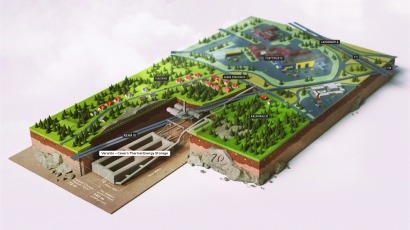
In Finland and other Nordic countries, the heat consumption varies significantly between seasons. Heat consumption in the summer time is only about one-tenth of the peak load consumption during the cold winter months. The possibility to store cheap and environmental friendly waste heat from datacenters, cooling processes and waste-to-energy assets in underground caverns is a revolutionary innovation in terms of the energy transition. The use and distribution of stored heat is ideally suited for Finland's and other Nordic countries' general district meeting network, to which the majority of properties are automatically connected.
The seasonal thermal energy storage facility will be built in Vantaa's bedrock, where a total of three caverns about 20 meters wide, 300 meters long and 40 meters high will be excavated. The bottom of the caverns will be 100 meters below ground level. These underground caverns will be filled with hot water. Pressure will be created within the space, allowing the water to reach temperatures of up to 140 degrees without the water boiling or evaporating.
The seasonal thermal energy storage caverns are huge; their total volume is 1,100,000 cubic meters, including process facilities. The volume of Varanto can be illustrated using a concrete comparison: the underground seasonal thermal energy storage facility is physically almost as large as two Madison Square Gardens.
"The world is undergoing a huge energy transition. Wind and solar power have become vital technologies in the transition from fossil fuels to clean energy. The biggest challenge of the energy transition so far has been the inability to store these intermittent forms of energy for later use. Unfortunately, small-scale storage solutions, such as batteries or accumulators, are not sufficient; large, industrial-scale storage solutions are needed. Varanto is an excellent example of this, and we are happy to set an example for the rest of the world," says Vantaa Energy CEO Jukka Toivonen.
The total thermal capacity of the fully charged seasonal thermal energy storage is 90 gigawatt-hours. This capacity could heat a medium-sized Finnish city for as long as a year. Broken down into smaller energy units, this amount of energy is equivalent to, for example, 1.3 million electric car batteries.
"Two 60-MW electric boilers will be built in conjunction with Varanto. These boilers will be used to produce heat from renewable electricity when electricity is abundant and cheap. Our heat-producing system will work like a hybrid car: alternating between electricity and other forms of production, depending on what is most advantageous and efficient at the time," notes Toivonen.
The project cost is estimated to be around 200 million euros, and it has already been awarded a 19-million-euro investment grant from Finland's Ministry of Economic Affairs and Employment. Construction of the storage facility's entrance is expected to start this year. The seasonal thermal energy storage facility could be operational in 2028.
District heating is the most popular form of heating for buildings and homes in Finland. This is made possible by the underground district heating network that most properties are connected to. There are more than 600 kilometers of underground district heating networks in Vantaa. Around 90% of Vantaa residents live in a home heated by district heating.
Relative to population, Finland is the largest producer of district heat in the Nordic countries. Heat produced in local thermal power plants is used to heat individual homes, commercial buildings and industrial production plants. In 2023, a total of 37.3 terawatt-hours of district heat was produced in Finland. Of this, 53% was produced from renewable heat sources and 14% from waste heat.
In district heating networks, the thermal energy produced in production plants is transmitted to customers as hot water in a closed, two-pipe district heating network. In these pipelines, the hot water flows to the buildings, and the water that has released its heat flows back to the production plant for reheating. The heat is always transferred to the building via heat exchangers, so the district heating water itself does not circulate in the heating networks of the buildings.
District heating is an environmentally sustainable option for a number of reasons. One of the advantages of district heating is that it is produced locally, close to the heat users. The energy that flows through the district heating network is as environmentally friendly as the generation forms connected to it. New forms of production and innovative technologies can be integrated into the district heating network as production methods evolve, making it highly adaptable.

